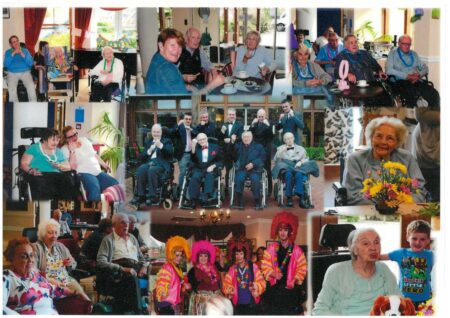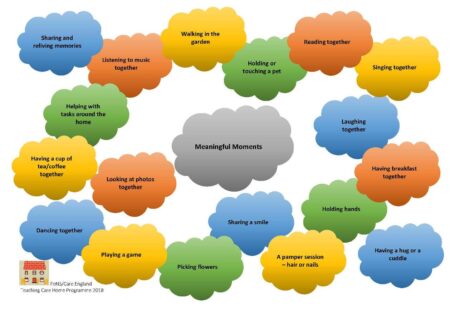Home News & Views Sharing meaningful moments
Sharing meaningful moments
Kate Sanders, FoNS Practice Development Facilitator

Last week when several of the teams involved in the Teaching Care Homes programme met, ideas were shared about the many ways in which staff can create ‘meaningful moments’ for people they are caring for. This was stimulated by one team sharing a poster that they had created to capture a variety of meaningful moments and some small rummage boxes that they had created together with people living in their care home (Royal Star and Garter in Solihull); and also, another team sharing (with permission) a memory box belonging to someone living in Wren Hall, showing the wide variety of contents that can help to stimulate conversations and memories. This included letters from her husband during the war that had been typed up so that they were easier to read; CDs of favourite music; and photos of family going back several generations.
 ‘Meaningful moments’ have been defined as ‘interpersonal encounters that are brief, yet evocative to the person with dementia’ (Stokes, 2016). This definition resonates with what David Sheard (2010) calls ‘Butterfly’ moments, when people’s lives are touched, when moments of short activity are created, or moments of stillness are shared. Stokes (2016) suggest that these moments will be at their most psychologically and emotionally meaningful if the care staff know the person, but similarly Sheard (2010) also recognises that anyone can touch and make a difference to a person’s day. Relationships start with a first moment of connection.
‘Meaningful moments’ have been defined as ‘interpersonal encounters that are brief, yet evocative to the person with dementia’ (Stokes, 2016). This definition resonates with what David Sheard (2010) calls ‘Butterfly’ moments, when people’s lives are touched, when moments of short activity are created, or moments of stillness are shared. Stokes (2016) suggest that these moments will be at their most psychologically and emotionally meaningful if the care staff know the person, but similarly Sheard (2010) also recognises that anyone can touch and make a difference to a person’s day. Relationships start with a first moment of connection.
We know that the pressure of time is a reality for most staff working in health and social care, but we also know that brief and meaningful encounters can have a positive impact on the well-being of people living in care homes; the Teaching Care Homes teams experience this on a daily basis. You only have to look at the photos to see this too. And arguably staff benefit too. We can all relate to the positive feeling that we get when we really connect with someone, even for the shortest of times.
 This kind of human connection is then not just relevant to the care home setting, it crosses all contexts and care encounters. How can we share a meaningful moment in A&E or in an out-patients clinic, for example?
This kind of human connection is then not just relevant to the care home setting, it crosses all contexts and care encounters. How can we share a meaningful moment in A&E or in an out-patients clinic, for example?
And so, the teams thought that they would like to share some of their ideas for creating ‘meaningful moments’. Please feel free to print off the poster – or perhaps you would like to create your own. We would love to share them if you do.
We also came across this useful resource – ‘Pocket ideas’ – which won ‘Best Acute Care Initiative’ at the Scottish Dementia Awards in 2014. It is a pocket tool designed with the intention that any member of staff in contact with older people could use the prepared prompts to begin a conversation. We hope you find it helpful.
References
Sheard, D. (2010) ‘Love is like a butterfly: occupying people living with a dementia in care homes. Retrieved from: http://www.dementiacarematters.com/pdf/OTnews2010.pdf
Stokes, G. (2016) Do meaningful moments have positive outcomes of care home residents living with sever dementia? Retrieved from: http://www.napa-activities.com/wp-content/uploads/2016/04/Stokes-Moments.pdf
Comments are closed.

